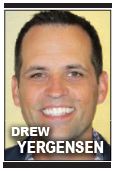Drew Yergensen
Each quarter, KeyBank surveys 400 owners and executives of businesses across the country with $10 million to $2 billion in revenues about the economy and its impact on their businesses. The most recent survey revealed that while some concerns have lifted — most notably COVID-19 and supply chain issues — inflation and higher operating costs remain stubborn challenges.
This quarter’s survey results show that the outlook in the middle market is looking up — but only slightly. Almost three-quarters (72 percent) of middle-market business leaders reported having a very good or excellent company outlook — up slightly from December. Perspectives varied considerably by industry: construction companies reported an{mprestriction ids="1,3"} above-average boost in positive sentiment, from 78 percent in December to 88 percent in the most recent survey; while in healthcare, those with an optimistic company outlook fell from 70 percent to 63 percent.
Inflation remains a top concern, with 43 percent reporting it as having a negative impact on their businesses in terms of increased costs for labor, raw materials, energy, oil and gas. The good news is fewer than one-third of respondents reported they were experiencing supply chain issues — the lowest number in more than a year. Concerns around cash flow and healthcare costs also abated after rising in December. Another good sign is that concerns about attracting and retaining qualified talent are subsiding, although certain segments continue to struggle.
Sentiment about the broader U.S. economy is up slightly, with 50 percent of the respondents reporting a very good or excellent outlook, up from 47 percent in December. In retail, the number of executives who felt optimistic about the economy increased nine points in Q1, although in manufacturing, that number decreased to 51 percent, from 57 percent in December.
Yet across the middle market, positive sentiment about the U.S. economy remains 11 percentage points lower than it was six months ago, reflecting a variety of ongoing challenges.
Most middle-market business leaders still expect an economic downturn before the end of 2023. Of those surveyed, 40 percent believed a downturn would happen during the first half of the year, while 41 percent expect it to hit in the third or fourth quarter. Among those who anticipate a downturn, 71 percent anticipate it will have a negative effect on their business.
With that in mind, businesses are taking action to safeguard against a recession by improving operational efficiencies and productivity (43 percent), identifying new markets, products or services to increase revenues (35 percent), searching for lower-cost suppliers (34 percent) and increasing business savings and liquidity (30 percent).
Respondents cited negative effects of inflation to include higher overhead costs (58 percent), increased costs of raw materials (54 percent) and increased costs of energy, oil and gas (54 percent). On the positive side, business owners cited the ability to raise prices (52 percent overall and 64 percent in the retail sector), increased incentives for the business to spend or invest (46 percent) and increased customer spending — e.g., building up inventories and buying ahead (45 percent).
Approaches taken to managing inflation and higher costs vary according to each company’s outlook. Those with a more positive outlook are looking to increase sales and marketing efforts to generate more customers and revenue (41 percent) and improve processes or create more operational efficiencies (37 percent). Business leaders with a more negative view are moving to identify alternative suppliers or sources of raw materials and commodities (38 percent) and pass increased costs onto customers through higher prices (38 percent).
While the most recent Middle Market Sentiment survey was fielded before and during the Silicon Valley Bank and Signature Bank closings in March, regional bank failures do not appear to have materially affected middle-market businesses in the short term. Only 16 percent of survey respondents expect cash flow concerns to have a negative impact on their businesses over the next 12 months, down from 21 percent the previous quarter.
In preparation for a recession, some leaders are taking precautionary liquidity management measures — 30 percent are increasing business savings and liquidity, while 25 percent are increasing their company’s line of credit and 21 percent are identifying new credit lenders.
Overall, middle-market business leaders are carefully monitoring economic conditions as well as their own prospects. For some, inflation and higher costs continue to put pressure on the bottom line. For others, the ability to raise prices has boosted margins. Some are having an easier time hiring the workers they need, while others are struggling to attract and retain qualified talent. The middle market has never been monolithic, but in moments of uncertainty, it becomes clearer than ever that the outlook for this crucial segment of the economy is as diverse as the businesses that comprise it.
Drew Yergensen is the market president and commercial banking leader with KeyBank in Utah.
This material is presented for informational purposes only and should not be construed as individual tax or financial advice. Please consult with legal, tax and/or financial advisors.{/mprestriction}








